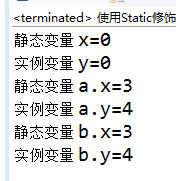这是原来的
class StaticDemo {
static int x;
int y;
public static int getX() {
return x;//静态方法中可以访问静态数据成员x
}
public static void setX(int newX) {
x = newX;
}
public int getY() {//int 前加static试试(静态方法中不可以访问非静态数据成员y)
return y;// 非静态方法中可以访问非静态数据成员y
}
public void setY(int newY) {//试试增加 x=20; 非静态方法中可以访问静态数据成员x
y = newY;
}
}
public class LX4_1 {
public static void main(String[] args) {
System.out.println("静态变量 x="+StaticDemo.getX());
System.out.println("实例变量 y="+StaticDemo.getY());//非法,编译将出错
StaticDemo a= new StaticDemo();
StaticDemo b= new StaticDemo();
a.setX(1);
a.setY(2);
b.setX(3); b.setY(4);
System.out.println("静态变量 a.x="+a.getX());
System.out.println("实例变量 a.y="+a.getY());
System.out.println("静态变量 b.x="+b.getX());
System.out.println("实例变量 b.y="+b.getY());
}
}
这是修改以后的
package hello;
public class 使用Static修饰符 {
public static void main(String[] args) {
// TODO Auto-generated method stub
System.out.println("静态变量 x=" + StaticDemo.getX());
System.out.println("实例变量 y=" + StaticDemo.getY());// 非法,编译将出错
StaticDemo a = new StaticDemo();
StaticDemo b = new StaticDemo();
a.setX(1);
a.setY(2);
b.setX(3);
b.setY(4);
System.out.println("静态变量 a.x=" + a.getX());
System.out.println("实例变量 a.y=" + a.getY());
System.out.println("静态变量 b.x=" + b.getX());
System.out.println("实例变量 b.y=" + b.getY());
}
}
class StaticDemo {
static int x;
static int y;
public static int getX() {
return x;// 静态方法中可以访问静态数据成员x
}
public static void setX(int newX) {
x = newX;
}
public static int getY() {// int 前加static试试(静态方法中不可以访问非静态数据成员y)
return y;// 非静态方法中可以访问非静态数据成员y
}
public static void setY(int newY) {// 试试增加 x=20; 非静态方法中可以访问静态数据成员x
y = newY;
}
}

最后
以上就是饱满猎豹最近收集整理的关于Java学习——使用Static修饰符的全部内容,更多相关Java学习——使用Static修饰符内容请搜索靠谱客的其他文章。
本图文内容来源于网友提供,作为学习参考使用,或来自网络收集整理,版权属于原作者所有。



![[javase高级] 资深java面试题及答案整理(二)](https://file2.kaopuke.com:8081/files_image/reation/bcimg5.png)




发表评论 取消回复